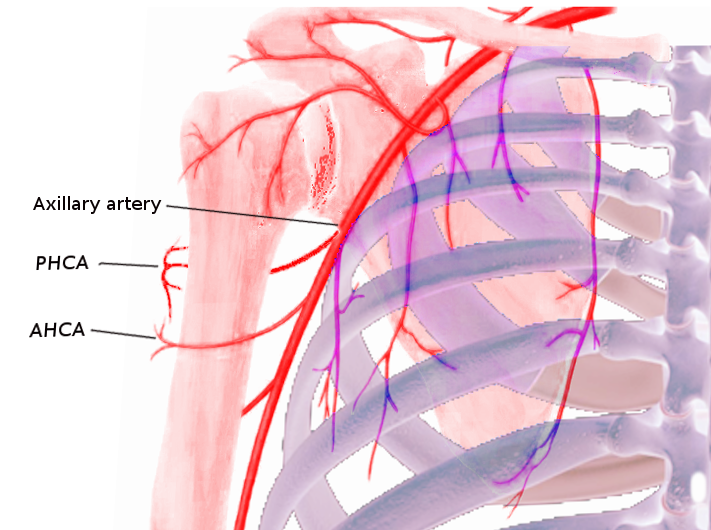[1]
Thiel R, Munjal A, Daly DT. Anatomy, Shoulder and Upper Limb, Axillary Artery. StatPearls. 2023 Jan:():
[PubMed PMID: 29489298]
[2]
Khan IA, Varacallo M. Anatomy, Shoulder and Upper Limb, Arm Quadrangular Space. StatPearls. 2023 Jan:():
[PubMed PMID: 30726009]
[3]
Galley IJ, Watts AC, Bain GI. The anatomic relationship of the axillary artery and vein to the clavicle: a cadaveric study. Journal of shoulder and elbow surgery. 2009 Sep-Oct:18(5):e21-5. doi: 10.1016/j.jse.2009.01.021. Epub 2009 Apr 11
[PubMed PMID: 19362855]
[4]
Mostafa E, Imonugo O, Varacallo M. Anatomy, Shoulder and Upper Limb, Humerus. StatPearls. 2023 Jan:():
[PubMed PMID: 30521242]
[6]
Juneja P, Hubbard JB. Anatomy, Shoulder and Upper Limb, Arm Teres Minor Muscle. StatPearls. 2023 Jan:():
[PubMed PMID: 30020696]
[8]
Hettrich CM, Boraiah S, Dyke JP, Neviaser A, Helfet DL, Lorich DG. Quantitative assessment of the vascularity of the proximal part of the humerus. The Journal of bone and joint surgery. American volume. 2010 Apr:92(4):943-8. doi: 10.2106/JBJS.H.01144. Epub
[PubMed PMID: 20360519]
[12]
Chang LR, Anand P, Varacallo M. Anatomy, Shoulder and Upper Limb, Glenohumeral Joint. StatPearls. 2024 Jan:():
[PubMed PMID: 30725703]
[13]
Epstein MD, Bhargava P, Medverd JR. A 48-year-old man with chronic right shoulder pain and weakness after a fall: diagnosis and discussion. Post-traumatic chronic axillary nerve injury. Skeletal radiology. 2010 May:39(5):505-6, 489-90. doi: 10.1007/s00256-009-0841-4. Epub
[PubMed PMID: 20127326]
[14]
Goldman EM, Shah YS, Gravante N. A case of an extremely rare unilateral subscapular trunk and axillary artery variation in a male Caucasian: comparison to the prevalence within other populations. Morphologie : bulletin de l'Association des anatomistes. 2012 Aug:96(313):23-8. doi: 10.1016/j.morpho.2012.03.001. Epub 2012 Sep 27
[PubMed PMID: 23022199]
Level 3 (low-level) evidence
[15]
Baral P, Vijayabhaskar P, Roy S, Kumar S, Ghimire S, Shrestha U. Multiple arterial anomalies in upper limb. Kathmandu University medical journal (KUMJ). 2009 Jul-Sep:7(27):293-7
[PubMed PMID: 20071879]
[16]
Durgun B, Yücel AH, Kizilkanat ED, Dere F. Multiple arterial variation of the human upper limb. Surgical and radiologic anatomy : SRA. 2002 May:24(2):125-8
[PubMed PMID: 12197022]
[17]
Cavdar S, Zeybek A, Bayramiçli M. Rare variation of the axillary artery. Clinical anatomy (New York, N.Y.). 2000:13(1):66-8
[PubMed PMID: 10617889]
[18]
Mohandas Rao KG, Somayaji SN, Ashwini LS, Ravindra S, Abhinitha P, Rao A, Sapna M, Jyothsna P. Variant course of posterior circumflex humeral artery associated with the abnormal origin of radial collateral artery: could it mimic the quadrangular space syndrome? Acta medica Iranica. 2012:50(8):572-6
[PubMed PMID: 23109033]
[19]
Smith CD, Booker SJ, Uppal HS, Kitson J, Bunker TD. Anatomy of the terminal branch of the posterior circumflex humeral artery: relevance to the deltopectoral approach to the shoulder. The bone & joint journal. 2016 Oct:98-B(10):1395-1398
[PubMed PMID: 27694595]
[20]
Brown SA, Doolittle DA, Bohanon CJ, Jayaraj A, Naidu SG, Huettl EA, Renfree KJ, Oderich GS, Bjarnason H, Gloviczki P, Wysokinski WE, McPhail IR. Quadrilateral space syndrome: the Mayo Clinic experience with a new classification system and case series. Mayo Clinic proceedings. 2015 Mar:90(3):382-94. doi: 10.1016/j.mayocp.2014.12.012. Epub 2015 Jan 31
[PubMed PMID: 25649966]
Level 2 (mid-level) evidence
[21]
Chen YX, Zhu Y, Wu FH, Zheng X, Wangyang YF, Yuan H, Xie XX, Li DY, Wang CJ, Shi HF. Anatomical study of simple landmarks for guiding the quick access to humeral circumflex arteries. BMC surgery. 2014 Jun 26:14():39. doi: 10.1186/1471-2482-14-39. Epub 2014 Jun 26
[PubMed PMID: 24970300]
[22]
Hangge PT, Breen I, Albadawi H, Knuttinen MG, Naidu SG, Oklu R. Quadrilateral Space Syndrome: Diagnosis and Clinical Management. Journal of clinical medicine. 2018 Apr 21:7(4):. doi: 10.3390/jcm7040086. Epub 2018 Apr 21
[PubMed PMID: 29690525]
[23]
Rollo J, Rigberg D, Gelabert H. Vascular Quadrilateral Space Syndrome in 3 Overhead Throwing Athletes: An Underdiagnosed Cause of Digital Ischemia. Annals of vascular surgery. 2017 Jul:42():63.e1-63.e6. doi: 10.1016/j.avsg.2016.10.051. Epub 2017 Mar 8
[PubMed PMID: 28284923]
[24]
Gorthi V, Moon YL, Jo SH, Sohn HM, Ha SH. Life-threatening posterior circumflex humeral artery injury secondary to fracture-dislocation of the proximal humerus. Orthopedics. 2010 Mar:33(3):. doi: 10.3928/01477447-20100129-29. Epub 2010 Mar 10
[PubMed PMID: 20349876]

